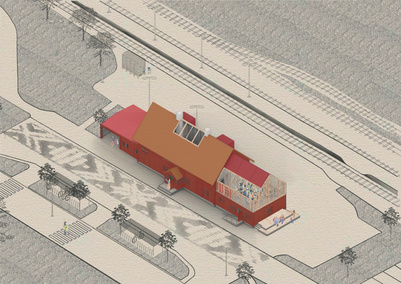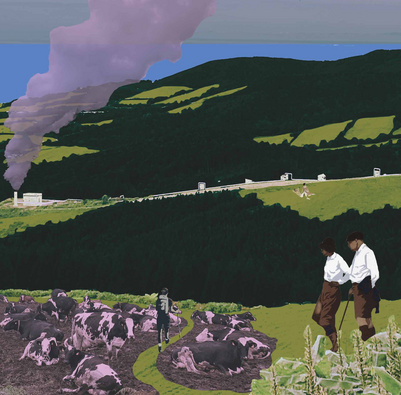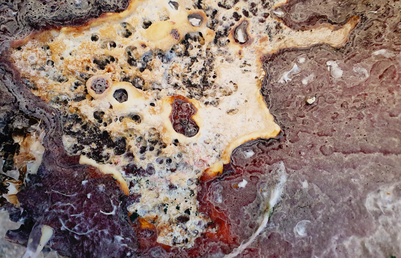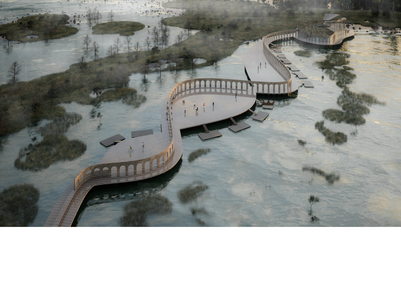The Impermanent Exhibition: An Interglacial and Archaeological Excavation of Construction Sites
The Impermanent Exhibition imagines the democratization of three stages in the construction of knowledge. By rendering forward the coexistence of archaeology and geology excavated in the soil of construction sites in Copenhagen, the discursive dichotomy of nature and culture is deconstructed.
The Archaeological Tent is situated alongside excavations in construction sites, forwarding a glimpse into the harvesting of archaeological and geological finds, and the tent changes location according to ongoing construction in Copenhagen.
The Laboratory Diorama is situated along with the continuation of the M4 metro line in Nordhavn, and functions as both the workspace of co-working archaeologists and geologists and as an open public laboratory in which citizens take part in the cleaning and conservation of finds.
The Exhibition Hall is situated in Nordhavnstippen, where the soil from construction sites is stored, waiting to be foundation of the proposed artificial island, Lynetteholm. The finds that have been translated into knowledge in the Laboratory Diorama, are re-inserted into the soil they were harvested from, exhibited alongside, and in dialogue with the soil.
The term impermanent challenges three notions of permanence in the existing museum institutions: The permanence of the architecture, the concept of the permanent exhibition, and therefore the notion of a static and isolated narration of time.
-> Access the Thesis Program to read the preliminary research on the dichotomy of natural and cultural history narration in museum institutions
-> Access the Museum Guide: The Permanent Exhibition to read about the three sites of the exhibition



How Glaciers and The Anthropocene Move Soil
Glacial geology and humans share a force; the ability to move soil. The moving of soil in construction sites excavate preserved history while paving the foundation for the future. The Anthropocene landscape grows, alters, and interacts with the environment, redefining the formation of lands. Digging forward the history of human settlements and the interglacial geology in the recent construction of the metro in Copenhagen frame a common history, in which all species and forces take part.




The Impermanent Exhibition, drawings: The Archaeological Tent, The Laboratory Diorama, and the Exhibition Hall
The Dichotomy of Nature and Culture in Museum Institutions
Preliminary to the establishment of the typology museum, the Wunderkammer of 15th-century Europe initiated the encyclopedia of collected objects. Like a microcosmos, it should represent the universe, categorized into two departments; the naturalia, represented by zoological, botanical, and geological objects, and the artificialia, objects created by the hand of humans. The division of nature and culture continuously reigns, dividing the narration of history into cultural history museums and natural history museums.
Thereby, the division of nature and culture from the renaissance is still inherent in our cultural institutions. Museums are often referenced as the people’s universities, underlining how they play a crucial role in educating the population, which raises the question: Should sources of knowledge, such as museums, still rely on the discursive conceptualization of nature and culture as separate narratives?
The project imagines a cross-disciplinary institution, enhancing cooperation among the geologist working with biopsies of the soil and the archaeologist working with finds embedded in the soil. The knowledge in the ground is treated as a coexisting event, rather than classified into different departments. The project is developed through three approaches of a co-evolutionary process: Through theoretical and spatial research, through fieldwork and interviews in the National Museum of Denmark, the Museum of Copenhagen, and The Natural History Museum, and through practice by modeling and drawing the hypotheses developed in research and fieldwork.


The National, The Universal, and the Situated
Through the study of the typologies of cultural and natural history museums, the territorialization of the narrative varies from the national museum, emphasizing a certain scope, the national, of belonging to the narrated history, and the natural history museum aims to narrate the universal history of nature. The territorial aim of the Impermanent Exhibition is in the situated: emphasizing the coexistence of species at the situation in which they take place.
Democratizing the Construction of Knowledge
Excavations
/ Trianglen, Østerbro. Metro-construction.
With the amount of construction work taking place in Copenhagen over time, leaving an Anthropocene geology, it is rare to find glacial periods in the ground. In the 1800th hundreds, the digging preliminary to the construction of Frihavnen revealed traces of shells from mussels and snails, descending from a milder interglacial climate. The lack of methods to date the geological biopsies left the question open, but the digging at Trianglen, Østerbro hosts similar properties and enriches the knowledge of the unknown interglacial period.
/ Rådhuspladsen. Metro-construction.
Underneath the pavement in Copenhagen are traces of the history of its construction, as a parallel timeline just below our feet. The digging in Rådhuspladsen, as part of the metro construction, revealed parts of the history of Copenhagen, dating back to the Vikings. A 1000-year-old graveyard site of skeletons was dug up, witnessing the life and territorialization of Copenhagen.
Laboratory Work
/ Trianglen, Østerbro. Metro-construction.
Enter the laboratory and take part in the analysis of biopsies of sediments found when digging in the ground of Trianglen, Østerbro. The laboratory is found in the second diorama space, visually connected to the washing area and the storage space of the translated knowledge. The biopsies are kept in the lower department building, entailing a walk from the lighter part of the building to the darker part, while descending the staircases. Underground, large, refrigerated storages are found, and a geologist will unfold the techniques of storage of the biopsies.
/ Rådhuspladsen. Metro-construction.
In the first diorama space, washing tables enable a close encounter with the archaeological finds. Guided by an archaeologist, the washing is facilitated as a careful process, as a first step into the conservation of the finds. The finds could be bones, human artifacts, or leftovers from built environments. In the third diorama space, conserved finds can be observed, and the window niches contain microscopes, in which the finds can be examined.
Exhibitions
/ Trianglen, Østerbro. Metro-construction.
Surrounded by the soil in which the geological layers have been deconstructed, biopsies of the interglacial stratigraphy are exhibited. The knowledge of ice ages is unfolded, relating to the current climate: we, too, are in an interglacial period.
/ Rådhuspladsen. Metro-construction.
The graves from the digging in Rådhuspladsen are re-inserted into the soil and placed underneath the boardwalk that curates the exhibition. Inhabiting the space underneath the boardwalk of other visitors spatially resembles the graves placed just one meter underneath Rådhuspladsen.













































